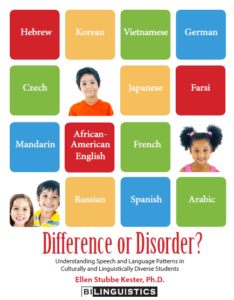Do we use language proficiency testing to determine which language we should use for speech-language testing?
NOOOOOOOOO!
Did I say that loudly enough?
This is a question we hear a lot.
“How do I determine the language of dominance so I know which language to use when testing my student?”
The purpose of language proficiency testing is NOT to determine the language to be used for a speech-language evaluation.
Let’s take a look at some of the history related to language proficiency tests.
There was a surge in language proficiency testing (and the development of language proficiency tests) in the early 2000s. The surge resulted from the No Child Left Behind Act of 2001, which required that English proficiency be assessed and that ELL students participate in a standards-based English language testing program. This increased the need for valid and fair assessments for ELLs (Stephenson, et al., 2003). A number of guidelines and resource guides were created to help educators through these changes. Gottlieb and colleagues (2007) created a resource guide to understanding English language proficiency standards. Pitoniak and colleagues (2009) published a set of guidelines for the assessment of English language learners.
Diving into these guides as well as other research on language proficiency testing, we came up with:
The Top 10 Purposes of Language Proficiency Tests

- To make determinations about when ESL support is no longer needed (Aldrich, 2011)
- Evaluate English language proficiency in school-aged children (Esquinca, Yaden, & Rueda, 2005)
- Measure cognitive-academic language proficiencies (The Woodcock Muñoz Language Survey, Woodcock et al., 2017)
- Assist in the initial identification, designation, and redesignation of a student as being non-English Speaking, Limited English speaking or Fluent English Speaking. (IDEA Proficiency Test)
- Measure those English and language skills necessary for functioning in mainstream academic environments (from The Language Proficiency Test, reported by Esquinca et al., 2005)
- Make classroom placement decisions for ELLs (Gottlieb et al., 2007)
- Aid in the identification of ELLs (Gottlieb et al., 2007)
- Optimize classroom instruction for English language learners (Stephenson et al., 2003)
- Assess students’ general acquisition of English (Stephenson et al., 2003)
- Evaluate progress in attaining English language proficiency (Pitoniak, et al., 2009)
Why we don’t use language proficiency testing for this purpose
Not a single source listed as its purpose determining language of testing. Now let’s talk about why we don’t use proficiency tests for this purpose.
When we test a bilingual student to determine whether or not they have a speech and/or language impairment, we need to evaluate both languages. We know that children who are raised in bilingual environments typically spend part of their day in one language and another part of their day in another language. Often they use one language at home and another language at school. They don’t talk about the same things in both languages. And, you guessed it, they don’t learn the same things in each language. So we really need to look at both languages to see all that they know.
Let’s add on top of that the fact that different languages have different structures. For example, Spanish and German have gender systems and require agreement between articles and nouns. English does not have such a system. For more details than you could every want on this, order a copy of our Difference or Disorder book. Let’s just sum it up by saying that we need to look at both languages to have a solid understanding of our students’ skills with linguistic structures and content.
References
- Aldrich, S. (2011). RTI for English Language Learners. Port Chester, NY: Dude.
- Esquinca, A., Yaden, D., & Rueda, R. (2005). Current language proficiency tests and their implications for preschool English language learners. In Proceedings of the 4th international symposium on bilingualism (pp. 674-680). Somerville, MA: Cascadilla Press.
- Gottlieb, M., Cranley, M. E., & Cammilleri, A. (2007). Understanding the WIDA English language proficiency standards: A resource guide. Board of Regents of the University of Wisconsin System.
- IDEA Language Proficiency Tests (IPT), 1991. Brea, Callifornia: Ballard & Tighe.
- Pitoniak, M. J., Young, J. W., Martiniello, M., King, T. C., Buteux, A., & Ginsburgh, M. (2009). Princeton, NJ: Educational Testing Service.
- Stephenson, A., Johnson, D. F., Jorgensen, M. A., & Young, M. J. (2003, November). Assessing English language proficiency: Using valid results to optimize instruction. In 81st Annual Meeting of the California Educational Research Association (CERA), Santa Barbara, California.
- Woodcock, R., Alvarado, C. G., Ruef, M. L., Schrank, F. A. (2017). The Woodcock-Muñoz Language Survey III. Boston: Houghton Mifflin Harcourt.




thank you gracias merci for articulating this so clearly! Time to reconceptualize the bilingual brain as far more than L1 + L2. Explore the work of Joanne Paradis & Kathryn Kohnert re vast heterogenaity & addressing full linguistic repertoire of multilingual speakers. As well as translanguing bilingual theory to inform and reshape our SLP perspectives.
Thanks, Theresa. I agree.
I just had a conversation yesterday before leaving work about this very topic. Thank you for the information!
You are welcome. I think a lot of us are having this conversation. And it’s an important one!
Good morning,
I just screened a K student whose L1 Spanish. is strong receptively but very minimal expressively. L2 English, presents average for both receptive and expressive during oral taks. I am a bilingual SLP assisting in these evals. before indicating formal testing. I use authentic tasks for oral lang. screening both languages (re-tell, of 4 or more step stories with 4 – 6 details depending on age, similarities/differences, wh questions, inferencing from given information etc.) Student is being referred for testing due to reading difficulties. I believe formal testing in Spanish would yield low scores due to expressive minimal skills. School SLP gave formal Eng. screen and child only missed items on sentence repetition and other grammar influenced tasks. Conversationally (discourse)during my screening in English is great.
Parent wants full evaluation for both speech and language. I am afraid scores will be misinterpreted. I believe reading (written lang/literacy) is affected by phonological awareness and other factors and not oral language impairment. Any suggestions?
Hi Gilda,
Great questions. I find that sometimes parents aren’t always sure exactly what to ask for. The bottom line is that they want help for their child. Often when we get a chance to have a conversation with a parent about the specifics of their concerns, we can guide them to what we think is the best approach.
Now, that said, if you are to end up doing full speech and language testing for this student, who you describe as having strong Spanish receptive skills, minimal expressive Spanish skills, and average skills receptively and expressively in English on informal tasks, I would use the PLS-5-Spanish, which is normed on children in the US from Spanish-speaking homes. It uses a conceptual scoring approach, which allows you get the picture of the child’s overall language skills rather than a score for each language. Even though this child is using more English expressively than Spanish, he/she still falls into description of the normative sample group, as a child who understands and speaks both Spanish and English.
Then pair those results with your informal results in which you mark all of the errors and show the family that errors are common Spanish-influenced English errors.
Good luck!